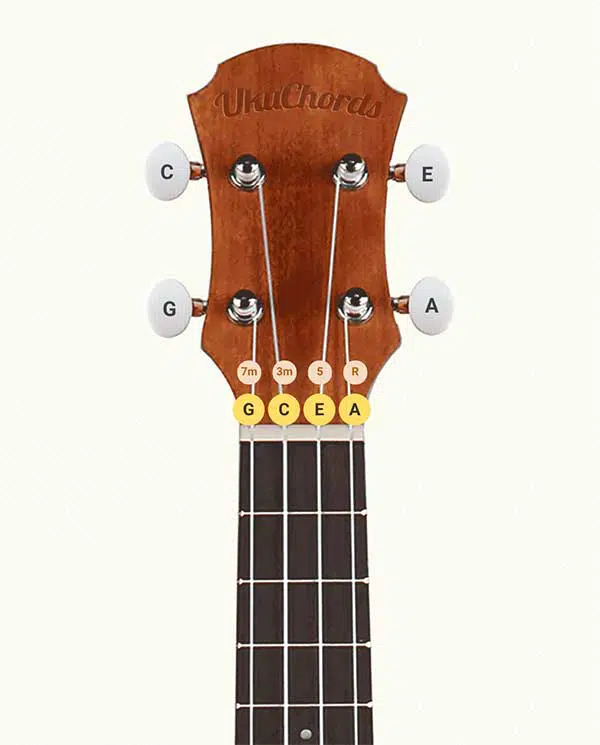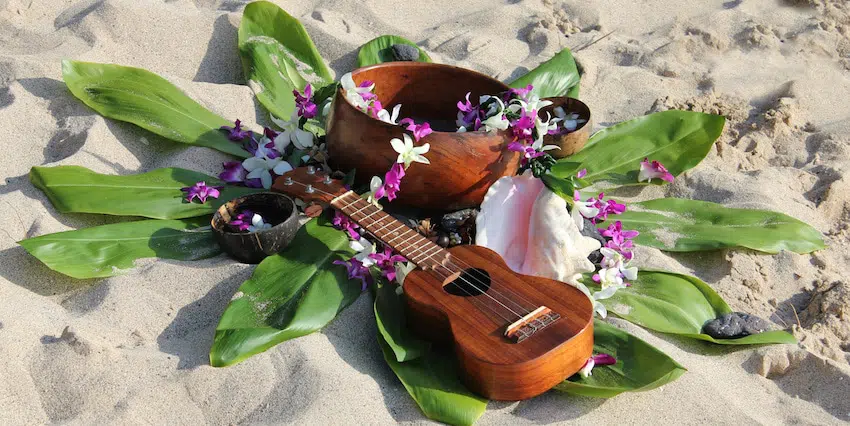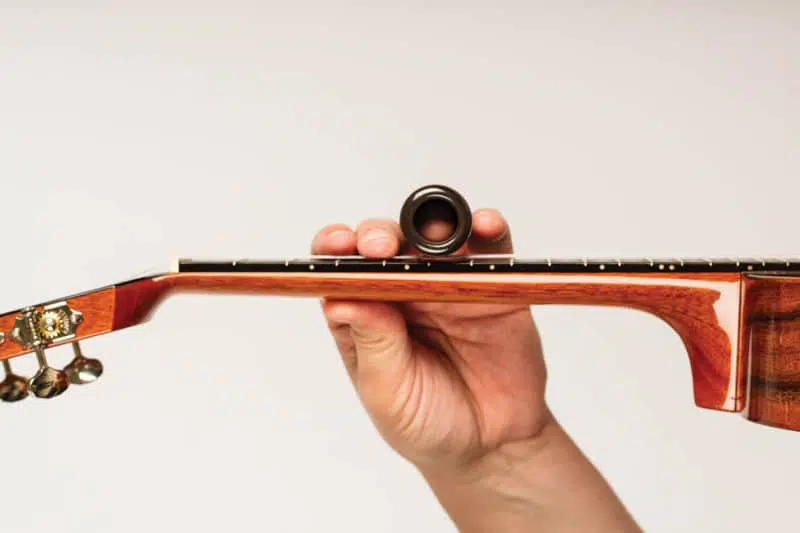“How should I tune my ukulele?“ That is probably one of the first questions that comes to mind when you’re just starting out playing the ukulele. What is the one correct tuning? Is it the same for all ukuleles? In this guide you’ll learn what the standard ukulele tuning is, D-tuning, LowG-tuning, slack-key tuning, slide tuning and baritone tuning. Learn how to tune a ukulele in this guide or use the UkuTabs ukulele tuner to tune within seconds for nine different alternate ukulele tunings.
What is the standard ukulele tuning?
The most commonly used tuning for a ukulele is g-C-E-A (sol – do – mi – la). Each letter indicates the pitch at which each of the four strings is tuned. The first letter means the tuning of the string nearest to you (the fourth string). A lower case g indicates a high g as opposed to a lower-sounding upper case written G. The next string (the third string) is tuned to C, the second to E and the string farthest away from you (first string) is tuned to A.

This tuning can be called different names: C-tuning, standard tuning, HighG tuning or re-entrant tuning. It’s noted down either as gCEA or G4 C4 E4 A4. On the other hand, LowG tuning is noted as G3 C4 E4 A4 as the G note is tuned one octave lower.
While this is the standard ukulele tuning, it is by far the only one possible. Tunings have changed over time and a lot of variety exists. Different players use different alternative tunings for their ukuleles to add either a different vibe to their playing style, experiment or because it’s easier. Read on for a good overview of the main alternative tunings. Nothing stops you from experimenting on your own of course!
D-Tuning for Ukulele
While this is an “alternate tuning” nowadays, years ago this was the standard ukulele tuning. Any music sheet for ukulele from the 1920s and 1930s will probably use D-tuning which is A-D-F#-B (la – re – fa# – si). With this tuning each string is tuned one tone or a whole step higher than C-tuning. It’s still typically used to see soprano ukuleles tuned as ADF#B, but concert or tenor ukuleles can be tuned to it as well.
It is believed that it makes the ukulele sound more Hawaiian and sweeter. You will probably run into this tuning for the soprano on the off chance that you dive into playing conventional Hawaiian music. While it produces a very nice ukulele sound, it’s mainly being replaced by gCEA as it’s easier to learn. On the other hand though, playing the E chord is much easier on D-tuned ukuleles.
You can tune your ukulele to ADF#B from gCEA by utilizing your A-string to tune your G-string to A. Once your G-string has been tuned up to A you can tune the other three strings up utilizing G-string reference notes.
Low-G Tuning for Ukulele
I’ve briefly touched on this tuning in the tuning. It’s not really an alternate tuning sensu stricto, it’s more a varying method to tune gCEA. On a typical ukulele, the C string will produce the lowest sounding pitch or note. Occasionally some players prefer to tune the first G note to a lower G. This can not be achieved with the standard gCEA strings that probably came with the ukulele. You need a specific lowG string to replace the first string. The most famous use of this tuning is by Israel Kamakawiwo’ole (also known as Iz) in the song “Over The Rainbow.”
Slack-Key Tuning for Ukulele
Slack key guitar (ki ho’alu) is a traditional Hawaiian way of tuning and playing the guitar. While more limited, the ukulele can successfully be used to play in a slack key style and is relatively easy to learn. It originated in Hawaii and is a method of taking certain strings and detuning or slacking them.

There are different version of the slack-key tuning, but the most commonly used one is open G or taro patch. Since the ukulele is tuned five steps higher than the guitar, that turns into C taropatch. To create it you tune the A string down one whole step to G. Strumming the open strings give you a ukulele slack key tuning of G-C-E-G.
Of course this means that all your normal chord positions are different, if you strum all the strings without any frets down you already have a C chord. By moving it two positions up and fretting 2222 you have a D chord. To play a basic C-F-G song you use 0000, 5555, 6666. This tuning works best while playing in the key of C and with C scales. This tuning also works great on many other instruments, especially the guitar.
Slide Tuning for Ukulele
When I say slide tuning, you probably immediately think of lap steels and guitars for using slide playing. However, it can be done on a ukulele as well! Instead of G-C-E-A change the A to Bb (or A#), that gives you G-C-E-Bb which is a C7. The seventh chord is the hallmark of blues, so with a slide ukulele tuning you can play some slide blues on the ukulele. You want to make sure you use a slide that isn’t too heavy. If you want, you can turn the ukulele on its side and play it like a mini lap steel. The key is that your slide covers all the strings and that you don’t press the slide all the way down to the frets. Just lightly touch all the strings and play your slide ukulele.

In this tuning you are moving the A up to a Bb, so be careful.Whenever you are experimenting with an alternate tuning, always slowly tune anything UP. If you go too far up in tuning you may break the string or damage the instrument. On the ukulele you are only moving up one and a half steps to Bb so it shouldn’t be too big a deal. This unique slide tuning will allow you to play some great slide blues for the ukulele. You will find this slide tuning works best on concert, tenor, or baritone ukuleles as the soprano may be a bit small.
Baritone GCEA
Baritone ukuleles are typically tuned as d-G-B-E, also called G-tuning. It’s common for larger ukuleles and gives you the same root notes as the bottom four strings of the guitar. You can however also tune your baritone ukulele to gCEA of course. Do not do this with the standard dGBE strings on the baritone ukulele as they will definitely break in the best case scenario, or destroy your ukulele in the worst case as its tuned 4 steps up.
An original baritone ukulele tuned to dGBE has more of a tenor guitar feel rather than a ukulele. Using specific GCEA baritone strings, you can now also get that ukulele sound on a baritone ukulele. Another added benefit is that the GCEA strings are not wound (metal) strings when compared with dGBE strings, for which your fingertips will be thankful.
To the moon!
There are many different ukulele tunings besides the standard C tuning. While some people will hang on to the “standard” GCEA tuning with their live, it can’t hurt to experiment. It will help you to think critically and get a better understanding of music theory. What’s keeping you from creating your own tunings? James Hill is for example known for his LowA (A3-D4-F#-B4) tuning. Try different tunings, learn different chord fingerings in those tunings, and you will be able to take your ukulele playing to a new and creative level!
Need more input?
I hope this guide has helped to explain the main different ukulele tunings out there and might encourage you to try out one.
Feel free to contact me whenever you need more information about buying the perfect baritone ukulele for you!
Perhaps you’re also interested in how to tune a ukulele or want to tune your ukulele to a special tuning immediately using the UkuTabs ukulele tuner with nine different alternate ukulele tunings.
